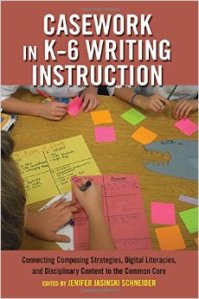 Casework in K-6 Writing Instruction, edited by Jenifer Jasinski Schneider, is a great book for any literacy coach’s bookshelf. The book describes nineteen different classroom vignettes, all centered around writing instruction. For example, one case describes the launching of a kindergarten writing workshop, while another case describes a one-on-one conference with a struggling writer. Here is a sampling of some of the other case titles:
Casework in K-6 Writing Instruction, edited by Jenifer Jasinski Schneider, is a great book for any literacy coach’s bookshelf. The book describes nineteen different classroom vignettes, all centered around writing instruction. For example, one case describes the launching of a kindergarten writing workshop, while another case describes a one-on-one conference with a struggling writer. Here is a sampling of some of the other case titles:
- “Not Your Grandmother’s Writing Lesson: Teaching Concepts and Conventions through Digital Interactive Writing (First Grade)”
- “‘This isn’t what we normally do:’ Test Preparation and the Teaching of Writing (Fourth Grade)”
- “Hot and Spicy Words: Motivating Writing and Vocabulary Development (Fifth Grade)”
Some, but not all, of the topics covered in the cases are balanced literacy, prompted writing, digital writing, word study, student choice, conferring with writers and mentor texts. Each case includes a narrative account of the classroom, as well as direct transcripts of both student and teacher language. Following each case is a set of discussion questions. For example, “What strategies could you use to prevent revision from becoming punishment for your students?” or “In this lesson, how are the Common Core Standards addressed?” Finally, each case is concluded with a section titled Reflection, which highlights some of the key concepts of writing instruction which are featured in the case. This Reflection section connects the cases to current writing research and theory. The cases included are very realistic and often imperfect. The book also contains a “Common Core Crosswalk” which highlights the relevant CCSS for each case. I especially appreciated this feature, making the book very user friendly for any literacy leader looking to use the book for staff development around the CCSS.
Literacy coaches or administrators could use this book in a number of ways:
- Cases could be read and discussed at weekly staff meetings as a jumping off point for larger issues in the field of writing.
- PLNs could use this book to discuss effective (or ineffective) writing instruction. The cases could be dissected and debated in study groups.
- Certain cases could be used to illustrate the application of the CCSS in any school still working to implement the CCSS.
- Grade-level teams could read and discuss the cases relevant to their grades.
- A review of a case along with a “What would you have done differently?” discussion among teacher teams.
The book is very easy to navigate and will be great fodder for discussion in any learning community.
GIVEAWAY INFORMATION:
This giveaway is for a copy of Casework in K-6 Writing Instruction. Many thanks to Jenifer Jasinski Schneider for donating a copy for one reader.For a chance to win this copy of Casework in K-6 Writing Instruction, please leave a comment about this post by Monday, January 26 at 11:59 p.m. CST. I’ll use a random number generator to pick the winner, whose name I will announce at the bottom of this post, by Wednesday, January 28th.Please be sure to leave a valid e-mail address when you post your comment, so I can contact you to obtain your mailing address if you win. From there, Jenifer Schneider will ship your book out to you. (NOTE: Your e-mail address will not be published online if you leave it in the e-mail field only.)If you are the winner of the book, I will email you with the subject line of COACHING CORNER BLOG – (Casework in K-6 Writing Instruction). Please respond to my e-mail with your mailing address within five days of receipt. Unfortunately, a new winner will be chosen if a response isn’t received within five days of the giveaway announcement.
Comments are closed.
Congratulations to the winner of Casework in K-6 Writing Instruction, Kristina Sacks. Her comment was:
The digital interactive writing in 1st grade sounds amazing. I can’t wait!
